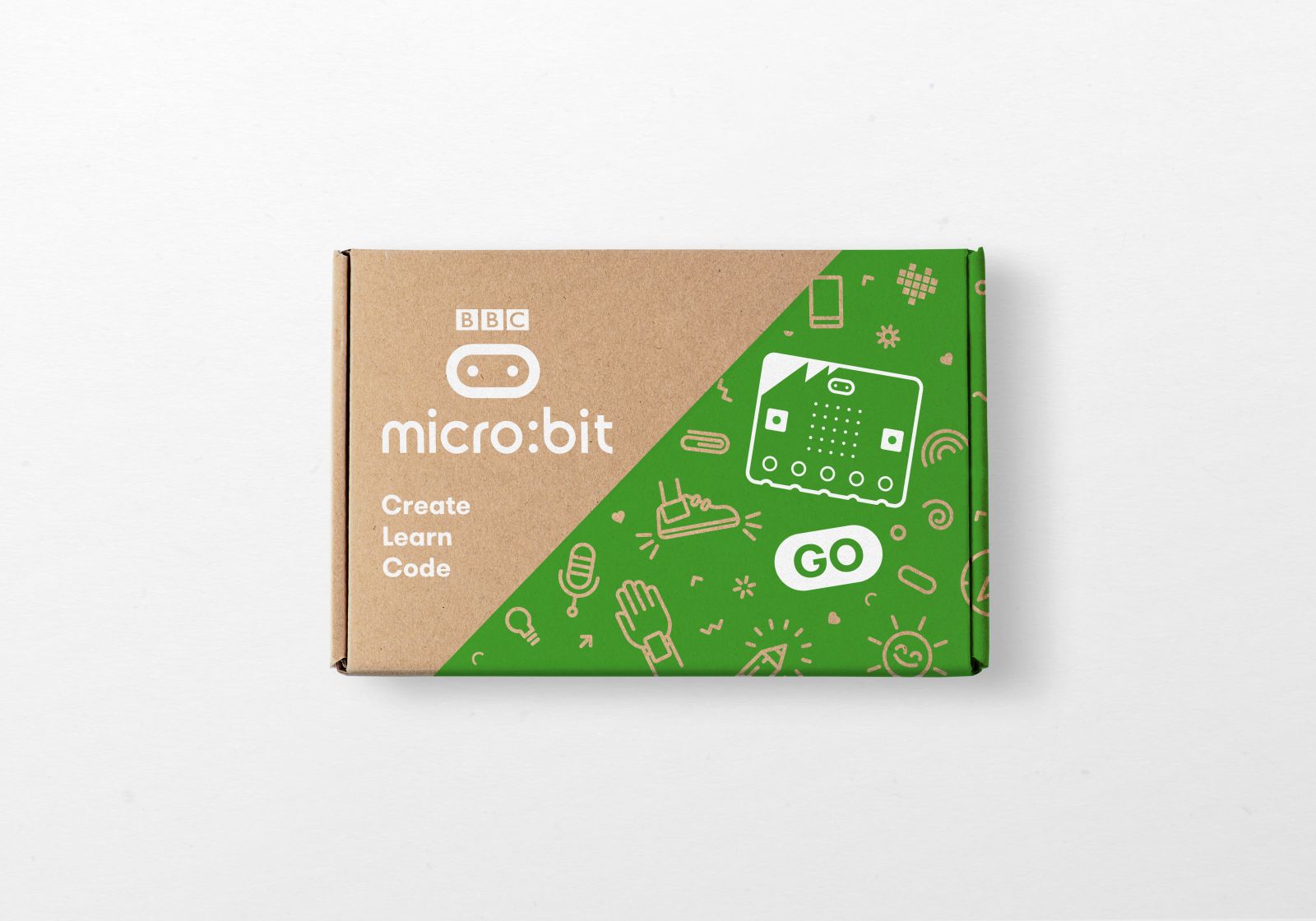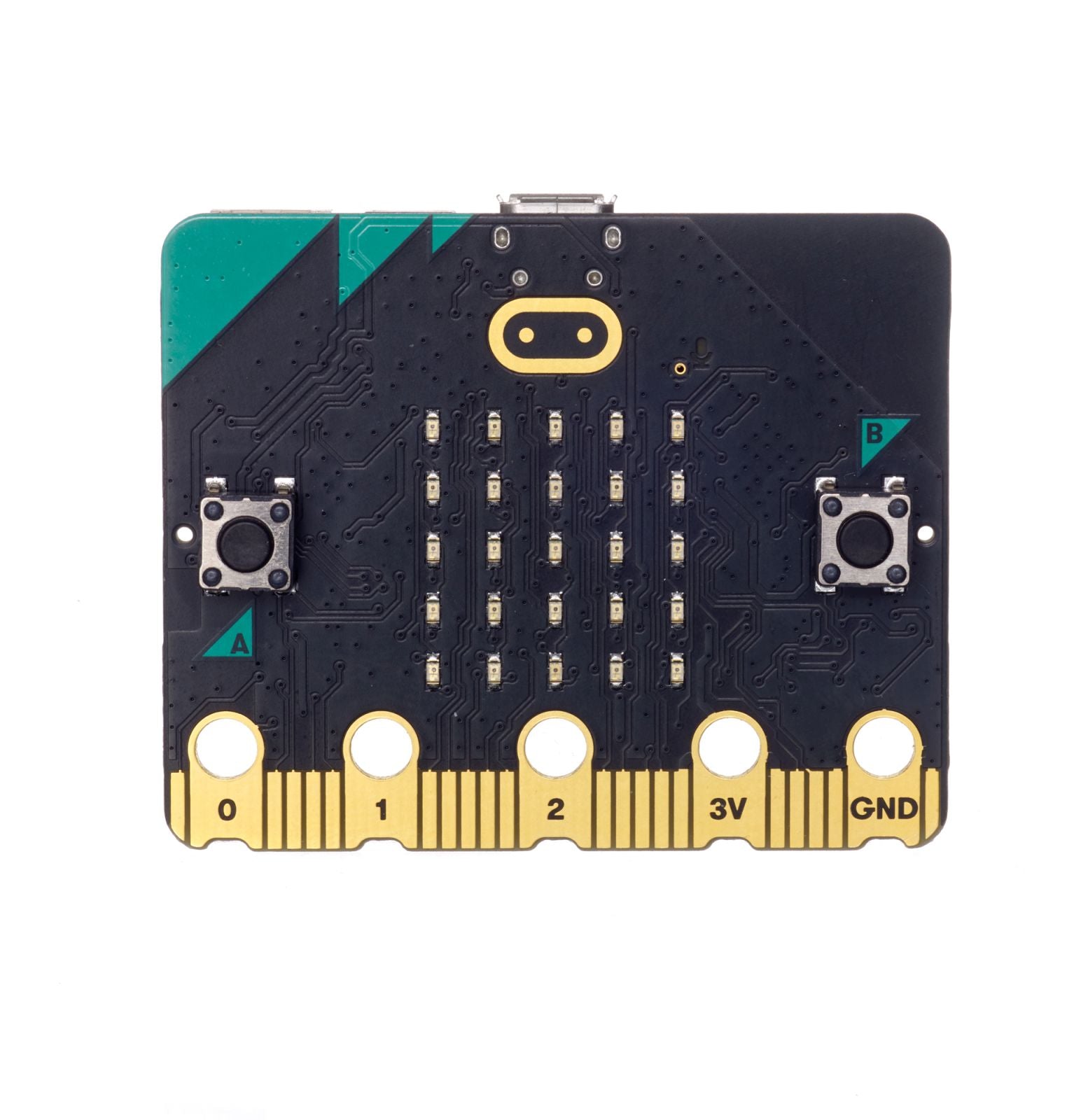Das micro:bit ist ein Single Board Computer (SBC), der einen Anwendungsprozessor mit eine Vielzahl von On-Chip-Peripheriegeräten. Andere Peripheriegeräte sind an diesen Chip angeschlossen. Ein Schnittstellenprozessor ist an den Anwendungsprozessor angeschlossen und verwaltet Kommunikation über die USB-Schnittstelle, einschließlich des Drag-and-Drop-Code-Blinkprozesses. Der Schnittstellenprozessor steuert keine der Peripheriegeräte auf der Karte, sondern ist mit dem Anwendungsprozessor auf dem internen Board I2C-Bus verbunden.
Merkmale
Prozessor
- Modell: Nordisch nRF52833
- Kernvariante: Arm Cortex-M4 32-Bit-Prozessor mit FPU
- Flash-ROM: 512KB
- Arbeitsspeicher: 128KB
- Geschwindigkeit: 64MHz
- Debug: SWD, J-Link/OB
Bluetooth
- Stack: Bluetooth 5.1 mit Bluetooth Low Energy(BLE)
- Band:
2,4GHz ISM (Industrie, Wissenschaft und Medizin)
2,4GHz..2,41GHz - Kanäle: 50 2MHz-Kanäle, nur 40 genutzt (0 bis 39), 3
- Werbekanäle: (37,38,39)
- Empfindlichkeit: -93dBm im energiesparenden Bluetooth-Modus
- Tx Leistung: -40dBm bis 4dBm
- Rolle: GAP Peripherie & GAP Zentral
- Stauvermeidung: Adaptives Frequenzsprungverfahren
- Profile: BBC micro:bit-Profil
Radio
- Protokoll: Mikro:bit-Funk
- Freq-Band: 2,4GHz
- Kanalrate: 1Mbps oder 2Mbps
- Verschlüsselung: Keine
- Kanäle: 80 (0..80)
- Gruppencodes: 255
- Tx-Leistung Acht vom Benutzer konfigurierbare Einstellungen von 0(-30dbm) bis 7 (+4dbm)
- Nutzlastgröße: 32 (Standard) 255 (falls rekonfiguriert)
Schaltflächen
- Typ: 2 taktile Benutzertasten, 1 taktile Systemtaste
- Software Debounce: (A & B) debounced, Zeitraum 54ms
- Pullup: (A & B) extern 4K7, (System) 10K
Display
- Typ: rote Miniatur-LED für Oberflächenmontage
- Physikalische Struktur: 5x5-Matrix
- Elektrische Struktur: 5x5
- Intensitätssteuerung: Softwaregesteuert bis zu 255 Stufen
- Erfassung der Umgebungslichtschätzung: mittels Software-Algorithmus
- Farbempfindlichkeit: rot zentrisch, rot ist 700 nm
Bewegungssensor
- Modell: LSM303AGR
- Merkmale: 3 Magnetfeld- und 3 Beschleunigungsachsen , 2/4/8/16g Bereiche
- Auflösung: 8/10/12 Bit
- Freifall"-Gesten an Bord
- Andere Gesten: Andere Gesten werden durch Software implementiert
- Algorithmen in der Laufzeit
Temperaturerfassung
- Kerngebundener Typ: NRF52
- Erfassungsbereich: -40C ... 105C
- Auflösung: 0,25C Schritte
- Genauigkeit: +/-5C (unkalibriert)
Lautsprecher
- Typ: JIANGSU HUANENG MLT-8530
- SPL: 80dB bei 5V, 10cm
- Eigenresonante: Frequenz 2700Hz
Mikrofon
- Typ-Kenntnisse: SPU0410LR5H-QB-7 MEMS
- Empfindlichkeit: -38dB ±3dB @ 94dB SPL
- SNR: 63dB
- AOP: 118db SPL
- Frequenzbereich: 100Hz ~ 80kHz
- Richtcharakteristik: Omnidirektional
PIN Belegung
- Rings 3 large IO rings and two large power rings, 4mm plug and crocodile
- clip compatible
-
GPIO features: 19 assignable GPIO pins
2 are dedicated to the external I2C interface
6 are used for display or light sensing feature
2 are used for on board button detection
1 is reserved for an accessibility interface
19 may be assigned as digital input or digital output
19 may be assigned for up to 3 simultaneous PWM channels
19 may be assigned for 1 serial transmit and 1 serial receive channel
6 may be assigned as analog input pins
3 may be assigned to an optional SPI communications interface
3 may be assigned for up to 3 simultaneous touch sensing inputs - ADC-Auflösung: 10 Bit (0..1023)
- Randverbinder: Randstecker
- Teilung: 1,27 mm, 80 Wege beidseitig.
- Pads: 5 Pads, mit 4mm Löchern
Netzteil
- Betriebsbereich: 1,8V .. 3,6V
- Betriebsstrom (USB und Batterie): 300mA maximal
- Budget für Onboard-Peripheriegeräte: 90mA
- Batteriestecker: JST X2B-PH-SM4-TB
- Max. bereitgestellter Strom: 190mA
Schnittstelle
- Modell: MKL27Z256VFM4
- Kernvariante: Arm-Kortex-M0+
- Flash-ROM: 256KB (128kB reserviert für zukünftige Verwendung als Speicher)
- Arbeitsspeicher: 16KB
- Geschwindigkeit: 48MHz
- Debug-Fähigkeiten: SWD
- Anschluss: USB-Mikro, MCR-B-S-RA-SMT-CS5-TR
- USB-Version: 2.0 Full Speed-Gerät
- Geschwindigkeit: 12Mbit/sec
- Unterstützte USB-Klassen: Massenspeicherklasse (MSC)
- Klasse der Kommunikationsgeräte: CDC
Debugging
- Protokoll: CMSIS-DAP
- Optionen: JLink/OB (über verschiedene Firmware)
Abmessungen
- Breite: 51,60 mm
- Höhe: 42,00 mm
- Länge: 11,65 mm
- Knopftiefe bis zur Platine: 4,55 mm
- Lautsprechertiefe bis Platine: 3,00 mm
- JST-Stecker bis Platte: 5,50 mm
Lieferumfang
- 1 micro:bit
- USB-Kabel
- Batteriehalter
- 2 AAA-Batterien
- Kurzanleitung
English Description
The micro:bit is a single board computer (SBC) that combines an application processor with a variety of on-chip peripherals. Other peripherals are connected to this chip. An interface processor is attached to the application processor and manages communications over the USB interface, including the drag-and-drop code blinking process. The interface processor does not control any of the peripherals on the board, but is connected to the application processor on the internal board I2C bus.
Features
Processor
- Model: Nordic nRF52833
- Core type: Arm Cortex-M4 32-bit processor with FPU
- Flash ROM: 512KB
- Main memory: 128KB
- Speed: 64MHz
- Debug: SWD, J-Link/OB
Bluetooth
- Stack: Bluetooth 5.1 with Bluetooth Low Energy(BLE)
- Band:
2.4GHz ISM (industrial, scientific and medical).
2.4GHz..2.41GHz
- Channels: 50 2MHz channels, only 40 used (0 to 39), 3
- Advertising channels: (37,38,39)
- Sensitivity: -93dBm in Bluetooth low power mode
- Tx power: -40dBm to 4dBm
- Role: GAP Peripheral & GAP Central
- Congestion Avoidance: Adaptive frequency hopping
- Profiles: BBC micro:bit profile
Radio
- Protocol: Micro:bit radio
- Freq band: 2.4GHz
- Channel rate: 1Mbps or 2Mbps
- Encryption: None
- Channels: 80 (0..80)
- Group codes: 255
- Tx power Eight user configurable settings from 0(-30dbm) to 7 (+4dbm)
- Payload size: 32 (default) 255 (if reconfigured)
Buttons
- Type: 2 tactile user buttons, 1 tactile system button
- Software Debounce: (A & B) debounced, period 54ms
- Pullup: (A & B) external 4K7, (System) 10K
Display
- Type: red miniature surface mount LED
- Physical structure: 5x5 matrix
- Electrical structure: 5x5
- Intensity control: software controlled up to 255 levels
- Ambient light estimation detection: by software algorithm
- Color sensitivity: red centric, red is 700 nm
Motion sensor
- Model: LSM303AGR
- Features: 3 magnetic field and 3 acceleration axes , 2/4/8/16g ranges.
- Resolution: 8/10/12 bit
- Free fall" gestures on board
- Other gestures: other gestures are implemented by software
- Algorithms in runtime
- Temperature detection
- Core-bound type: NRF52
- Detection range: -40C ... 105C
- Resolution: 0.25C steps
- Accuracy: +/-5C (uncalibrated)
Speaker
- Type: JIANGSU HUANENG MLT-8530
- SPL: 80dB at 5V, 10cm
- Inherent resonance: frequency 2700Hz
Microphone
- Type Knowledge: SPU0410LR5H-QB-7 MEMS
- Sensitivity: -38dB ±3dB @ 94dB SPL
- SNR: 63dB
- AOP: 118db SPL
- Frequency response: 100Hz ~ 80kHz
- Polar pattern: Omnidirectional
PIN Assignment
- Rings 3 large IO rings and two large power rings, 4mm plug and crocodile
clip compatible
- GPIO features: 19 assignable GPIO pins
- 2 are dedicated to the external I2C interface
- 6 are used for display or light sensing feature
- 2 are used for on board button detection
- 1 is reserved for an accessibility interface
- 19 may be assigned as digital input or digital output
- 19 may be assigned for up to 3 simultaneous PWM channels
- 19 may be assigned for 1 serial transmit and 1 serial receive channel
- 6 may be assigned as analog input pins
- 3 may be assigned to an optional SPI communications interface
- 3 may be assigned for up to 3 simultaneous touch sensing inputs
- ADC resolution: 10 bit (0..1023)
- edge connector: edge connector
- Pitch: 1.27 mm, 80 ways on both sides.
- Pads: 5 pads, with 4mm holes
Power supply
- Operating range: 1,8V .. 3,6V
- Operating current (USB and battery): 300mA maximum
- Budget for onboard peripherals: 90mA
- Battery connector: JST X2B-PH-SM4-TB
- Max. supplied current: 190mA
Interface
- Model: MKL27Z256VFM4
- Core Type: Arm Cortex-M0+
- Flash ROM: 256KB (128kB reserved for future use as memory)
- Memory: 16KB
- Speed: 48MHz
- Debug Capabilities: SWD
- Connection: USB Micro, MCR-B-S-RA-SMT-CS5-TR
- USB version: 2.0 full speed device
- Speed: 12Mbit/sec
- Supported USB Classes: Mass Storage Class (MSC)
- Communication device class: CDC
Debugging
- Protocol: CMSIS-DAP
- Options: JLink/OB (via different firmware)
- Dimensions
- width: 51.60 mm
- Height: 42.00 mm
- length: 11.65 mm
- Button depth to PCB: 4.55 mm
- speaker depth to board: 3.00 mm
- JST connector to board: 5.50 mm
Scope of delivery
- 1 micro:bit
- USB cable
- Battery holder
- 2 AAA batteries
- Quick start guide
Sicherheitsangaben
- Lesen Sie die Bedienungsanleitung sorgfältig durch, bevor Sie das Produkt verwenden.
- Stellen Sie sicher, dass alle Montage- und Installationsanweisungen des Herstellers sorgfältig befolgt werden.
- Verwenden Sie das Produkt nur für den vorgesehenen Zweck.
- Die unsachgemäße Nutzung dieses Produkts kann zu schweren Verletzungen oder Sachschäden führen.
- Nicht für Kinder unter 10 Jahren geeignet.
- Bei unsachgemäßer Verwendung besteht eine Verletzungsgefahr.
- Dieses Produkt entspricht den geltenden Sicherheitsanforderungen der Europäischen Union.
- Dieses Produkt wurde gemäß der GPSR geprüft, die sicherstellt, dass alle relevanten Sicherheitsanforderungen für Konsumgüter eingehalten werden.
Nachverfolgbarkeitsinformationen
Jedes Produkt verfügt über eines oder mehrere der folgenden Merkmale:
- Ein CE-Kennzeichen, das die Einhaltung der Sicherheits-, Gesundheits- und Umweltschutzanforderungen der Europäischen Union anzeigt.
- Eine eindeutige Serien- oder Chargennummer, um die Nachverfolgbarkeit zu gewährleisten und bei Bedarf Rückrufaktionen zu unterstützen.
- Hersteller- und Importeurangaben für den Kundensupport und Sicherheitsanfragen.
Überwachung und Berichterstattung von Vorfällen
Für den unwahrscheinlichen Fall eines Produktproblems haben wir Verfahren implementiert, um:
- Kundenbeschwerden zeitnah bearbeiten.
- Schwerwiegende Vorfälle über das EU Safety Gate/RAPEX-System melden.
- Mit den Marktüberwachungsbehörden zusammenarbeiten, um die öffentliche Sicherheit zu gewährleisten.
Kontakt:
- Email: support [@] pi3g.com
- Telefon: 0341 / 392 858 40
Dieses Produkt ist vollständig mit allen geltenden EU-Vorschriften konform, um die Sicherheit unserer geschätzten Kunden zu gewährleisten.




